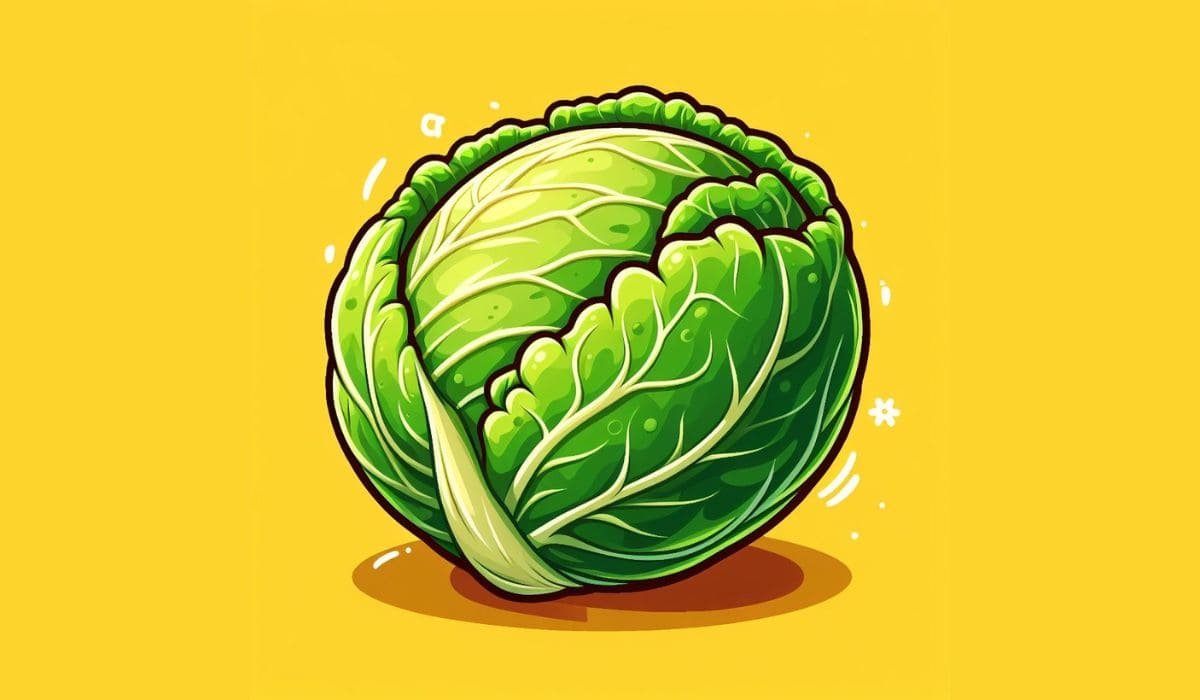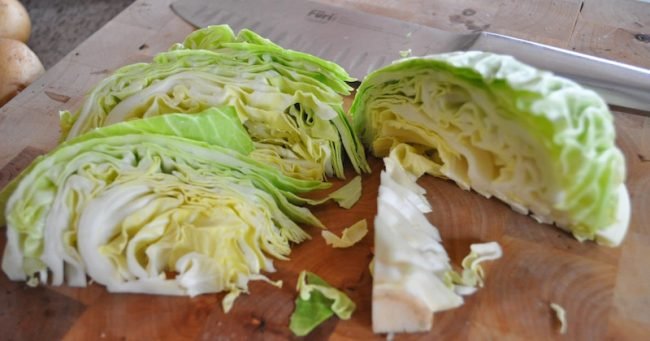7 Cabbage Health Benefits According To Science

Cabbage (Brassica oleracea), is a leafy green vegetable with a dense-leaved head. It’s a direct descendant of the wild cabbage and a close relative of cauliflower and broccoli.
The size varies – some heads can be as small as 500 gr., while larger can grow up to 4 kg. Apart from being prepared into a variety of delicious dishes, cabbage has been a big part of natural medicine for centuries, all thanks to the rich fiber content and the variety of essential nutrients it contains.
The nutritional profile of cabbage includes vitamins A, C, and K, as well as fiber and plenty of minerals.
Additionally, all cruciferous veggies contain the so-called glucosinolates (sulfur compounds) that have anti-cancer properties. [1] We’re not saying that cabbage can defeat cancer, but its potential is promising.
In this article, I present you the health benefits of cabbage that are backed up by scientific literature.
Cabbage Health Benefits

Here are some of the best health benefits of cabbage that are backed up by scientific studies.
- Helps with Digestion
- Heals wounds faster
- Fight inflammation
- Helps with Type-2 Diabetes
- Protects the heart
- Has anti-cancer properties
- Detoxifies the Liver
Helps with Better Digestion
Cabbage helps with digestion in many ways. First of all, its packed with dietary fiber which promote regular bowel movements, preventing constipation.
Fiber found in cabbage also supports a healthy gut microbiome by feeding beneficial gut bacteria. Cabbage’s glucosinolates break down into antimicrobial substances, guarding the stomach against harmful bacteria.
Finally, cabbage has high water content, which helps prevent dehydration, ensuring proper hydration levels for optimal digestion.
Heals Wounds Faster
Cabbage is an excellent source of Vitamin K – which helps in blood clotting. Just for context, blood clotting is the process which makes our wounds heal faster. The blood clots and closes the wound.
Apart from blood clotting, if you are low on vitamin K, you risk increased osteoporosis and fractures due to its role in bone metabolism.
Low levels of Vitamin K may also contribute to cardiovascular problems like arterial calcification, atherosclerosis, and potentially impact brain function, leading to cognitive decline and an elevated risk of neurodegenerative diseases. [2] [3]
Additionally, vitamin K deficiency may cause gastrointestinal issues by affecting fat-soluble vitamin absorption.
Cabbage contains 76mg of Vitamin K per 100 grams which is around 50% – 60% of our minimum daily intake.
Fights Inflammation
Chronic inflammation is something that deteriorates our bodies over a long period of time. Fortunately cabbage comes to the rescue.
- A 2022 study in Frontiers in Pharmacology explored the potential anti-inflammatory effects of miR172a from Brassica oleracea, known for cabbage leaf compresses (miR172a refers to a specific type of microRNA molecule). In lab tests, this plant-derived miRNA reduced FAN protein levels associated with inflammation in human and mouse cells. In a mouse model of rheumatoid arthritis, treatment with miR172a decreased inflammation-induced paw swelling.
Helps with Type-2 Diabetes
Cabbage can also prevent Type-2 Diabetes but also help manage it.
- A 2021 article in the Journal of Food Science emphasizes that cabbage varieties like green, white, and red cabbage contain bioactive compounds that help regulate glucose levels. Scientific evidence suggests that cabbage not only influences glucose control but also reduces damage to organs affected by Type 2 diabetes. It’s considered a valuable food for nutritional therapy and preventing and treating Type 2 diabetes.
Protects Heart from Oxidative Stress
Cabbage can also protect your heart from oxidative stress.
- A 2018 study in “Evidence-Based Complementary and Alternative Medicine” found that cabbage extract protects heart cells from oxidative stress, linked to heart diseases. The extract prevents cell damage, reduces harmful substances (ROS), and boosts antioxidants in heart cells. It also stops cell death, regulates specific proteins, and maintains cell energy production.
Has Anti-Cancer Properties
Cabbage is rich in bioactive compounds such as glucosinolates, which have been identified to have anticancer properties.
- A 2019 study published in the journal “Biomedicines” explored the anti-tumor and antimicrobial properties of two glucosinolate family members, sinigrin and glucoraphanin, found in cabbage and other cruciferous vegetables. These compounds act as potent antimicrobials, combating antibiotic-resistant bacteria and fungi. Also, due to their antioxidant enzymes, they can stop potential carcinogens and are proven promising in cancer treatment.
- Another 2020 study published in the journal “RSC Advances” explored the health benefits of young shoots of red cabbage compared to the mature vegetable. The study found that young shoots contain higher levels of vitamin C, carotenoids, and antioxidants – contributing to potential anticancer properties. Juices from young shoots demonstrate stronger anti-proliferation effects on prostate cancer cells compared to the mature vegetable’s juice. The study concluded that incorporating young shoots of red cabbage for health benefits, including cancer prevention.
Detoxifies The Liver
Consuming cabbage often will detoxify your liver and treat a variety of problems caused by it.
- A 2022 study published in the journal Biomarkers found that cabbage juice has a protective effect against lead-induced toxicity in male Wistar rats. The research involved treating rats with lead acetate and cabbage juice for 28 days. Cabbage juice significantly reduced liver and kidney dysfunction caused by lead, as indicated by lower levels of urea, creatinine, ALP, AST, and ALT in the blood. The study also showed that cabbage juice enhanced the antioxidant defense system in liver and kidney tissues, mitigating the harmful effects of lead exposure.
To get the most out of cabbage, you should consume it raw or juiced. Steamed and fermented cabbage works just as well – sauerkraut is an excellent source of vitamin C which is great for your immune system and can easily prevent colds and the flu.
Potential Side Effects
Although cabbage is a nutritious vegetable that offers many health benefits (as seen earlier), it can also have potential side effects for some individuals.
Here are some of the potential side effects linked with cabbage consumption:
- Gastrointestinal Discomfort: Cabbage contains complex carbohydrates called raffinose [2] that humans cannot digest because we lack the enzyme to break them down. [3] When bacteria in the large intestine ferment these carbohydrates, it can lead to gas and bloating.
- Hypothyroidism Concerns: Cabbage and other cruciferous vegetables contain goitrogens, substances that can interfere with thyroid hormone synthesis by inhibiting iodine uptake in the thyroid gland. [4] In excessive amounts, this could potentially contribute to hypothyroidism (underactive thyroid), especially in people with an existing iodine deficiency.
- Foodborne Illness Risk: If not properly washed or if consumed raw as in coleslaw or salads, cabbage may harbor harmful bacteria such as E. coli or Salmonella which can lead to food poisoning.
- Medication Interactions: Vitamin K present in cabbage plays a key role in blood clotting processes. High intake of vitamin K-rich foods may interact with anticoagulant medications like warfarin (Coumadin) by reducing their effectiveness.
- Colic in Breastfed Infants: Some studies suggest that certain compounds found in cabbage might pass into breast milk and could cause colic symptoms in sensitive infants when consumed by breastfeeding mothers.
- Allergic Reactions: Although rare, some individuals may have an allergy to cabbage which can result from both raw and cooked forms leading to symptoms like itching, swelling or hives upon consumption.
- Flatulence and IBS Symptoms: For those suffering from irritable bowel syndrome (IBS), certain types of fiber present in cabbage might increase symptoms like abdominal pain, diarrhea or constipation due to its high insoluble fiber content.
It’s important to note that most people will not experience any adverse effects from eating cabbage – if it is consumed as part of a varied diet and within reasonable amounts.
Cabbage Nutritional Profile
Here’s the nutritional facts of cabbage per 100 grams, as taken from USDA’s website. The below data habe been stripped away from non-important nutrients such as tocopherol, starch etc.
Also note that the data is for Raw cabbage (not cooked), more specifically the Brassica oleracea type (there are many types of cabbage) – which is the common green cabbage.
Finally, keep in mind that 1 cup, chopped cabbage is about 100 grams.
| Nutrient | Amount per 100g |
|---|---|
| Water | 92.2g |
| Energy | 25 kcal |
| Total Lipid (Fat) | 0.1g |
| Carbohydrates | 5.8g |
| Dietary Fiber | 2.5g |
| Total Sugars | 3.2g |
| Calcium, Ca | 40mg |
| Iron, Fe | 0.47mg |
| Magnesium, Mg | 12mg |
| Phosphorus, P | 26mg |
| Potassium, K | 170mg |
| Sodium, Na | 18mg |
| Zinc, Zn | 0.18mg |
| Copper, Cu | 0.019mg |
| Manganese, Mn | 0.16mg |
| Selenium, Se | 0.3µg |
| Fluoride, F | 1µg |
| Vitamin C | 36.6mg |
| Thiamin | 0.061mg |
| Riboflavin | 0.04mg |
| Niacin | 0.234mg |
| Pantothenic acid | 0.212mg |
| Vitamin B-6 | 0.124mg |
| Folate, total | 43µg |
| Choline, total | 10.7mg |
| Betaine | 0.4mg |
| Vitamin B-12 | 0µg |
| Vitamin B-12, added | 0µg |
| Vitamin A, RAE | 5µg |
| Retinol | 0µg |
| Carotene, beta | 42µg |
| Carotene, alpha | 33µg |
| Vitamin A, IU | 98 IU |
| Lycopene | 0µg |
| Lutein + zeaxanthin | 30µg |
| Vitamin E (alpha-tocopherol) | 0.15mg |
| Vitamin D (D2 + D3) | 0µg |
| Vitamin K (phylloquinone) | 76µg |
| Fatty acids, total saturated | 0.034g |
| Cholesterol | 0mg |
| Tryptophan | 0.011g |
| Threonine | 0.035g |
| Isoleucine | 0.03g |
| Leucine | 0.041g |
| Lysine | 0.044g |
| Methionine | 0.012g |
| Cystine | 0.011g |
| Phenylalanine | 0.032g |
| Tyrosine | 0.019g |
| Valine | 0.042g |
| Arginine | 0.075g |
| Histidine | 0.022g |
| Alanine | 0.042g |
| Aspartic acid | 0.122g |
| Glutamic acid | 0.294g |
| Glycine | 0.03g |
| Proline | 0.048g |
Frequently Asked Questions
Bottom Line
Cabbage is indeed a powerhouse when it comes to its nutrition profile. It’s science backed benefits make it an undeniable ally in your fight for good health.
Just keep in mind that it is better t o steam it – to avoid nutrient loss, and if you observe any side effects or your have thyroid problems, consult your personal doctor.
Read Next
